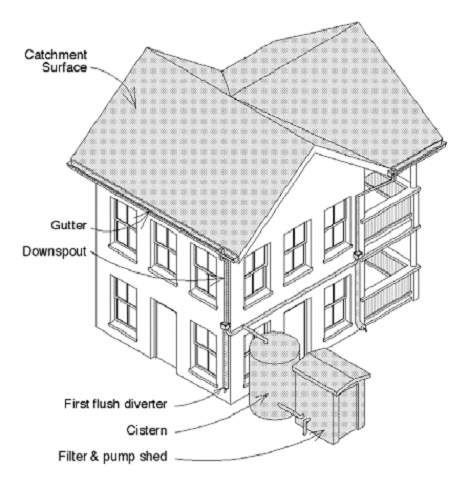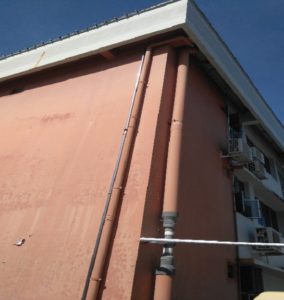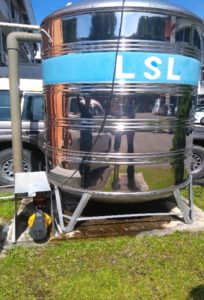RAINWATER HARVESTING SYSTEM GUIDELINE IN BRUNEI
Prepared by: Chin Xin Ying and Nabilah Najah bte Saleh
Green Brunei Interns from UTB taking Bachelor of Engineering, Civil and Structural Engineering
Objective of this guideline:
To provide interested homeowners with basic information on how to plan a rainwater harvesting system in residence.
How rainwater harvesting system (RWH) works?
It is a technology used for collecting, conveying and storing rainwater which can be used for non-potable purposes such as flushing system, gardening and external uses. Raw water collected from RWH systems is not fit for human consumption because the raw water needs to be treated by stringent disinfecting system to achieve potable quality. RWH can be installed in any type of houses or buildings, as long as there is catchment area or surface to collect rainwater. In Brunei, roofs of buildings is commonly used as catchment areas.
Why rainwater harvesting?
- Brunei has very high rate of water consumption at 450 liter per capita per day which will become unsustainable in the long run. One way to conserve water is by installing rainwater harvesting system at home which could be used for toilet flushing system and agriculture.
- Treating and supplying raw water is a very expensive process as it involves construction and maintenance of dams, water treatment plants and pipelines. Using harvested rainwater can help the country in reducing capital investment and cost of producing water.
- Rainwater is good for landscape irrigation. It is free from many chemicals found in ground water.
- It can reduce the volume of storm water during rainy reason, thereby lessening the impact of flooding and soil erosion.
- During the drought period or irregular period of rain, it can supply water for agriculture and garden’s plant.
What are the components of rainwater harvesting system?



Catchment surface: roof of a house or building for collecting rainwater.
Conveyance network: external gutter, downspouts and drainage piping channel water from roof to tank.
Rainwater storage tank: store rainwater harvested from roof catchments.
Overflow drainage piping: excess water is allowed to overflow through piping.
Water pump: allow water from the rainwater tank to be pressurized and delivered to higher elevations in building.
Is water pump compulsory for the rainwater harvesting system?
It depends on the intended end use of the water and location of the tank. If it is solely for external use (e.g. agriculture), then water can flow with the help of gravity pressure without using pump. Pump may be required when there is not enough pressure to deliver to buildings (e.g. flushing system) due to elevation differences.
How can I do simple rainwater treatment before using it?
There are various ways of treating rainwater prior to storage depending on the intended end use of the water. These techniques are commonly used:
- Filtration involves screening out leaves and large debris from runoff, preventing their entry into the rainwater storage tank. It can take place at or near the catchment surface in the form of screens placed over gutters or in the downspout.
- First-flush diversion involves diverting the first portion of runoff (collected from the catchment surface) away from the storage tank. It get rids of smaller contaminant such as dust, pollen, bird and rodent feces, the majority of which are contained in the first portion of runoff (first flush).
How do I size my system?
The storage capacity of the system depends on the location’s rainfall data, available catchment area and intended applications.
One simple way to roughly estimate the size the system can be done through SamSamWater Rainwater Harvesting Tool – www.samsamwater.com/rain
The steps are as follows:
1. Input the location where rainwater system is to be installed.

2. Select size (in m2) and type of roof.

3. Input water demand

Alternatively, water demand can be calculated using the values from Table 1 which shows estimated amount of water used for flushing and external uses.

4. Summary of result analysis

The result analysis page will provide information of the water demand, water supply based on annual rainfall data in Brunei and the sizing system that may be installed.
How much does it cost?
Adding up the prices for each of the components can give a very rough estimation of how much it might cost to build rainwater harvesting system. The price may vary depending on the type of system used, size of storage needed and the intended end use of the water (i.e. irrigation, flushing system).

Is there any regulations needed from government to install rainwater harvesting system in Brunei?
At the moment, there is no regulation or permit required from the government for the installation of rainwater harvesting system in Brunei. However, it is important to prevent contamination of the rainwater harvested and end user should also have knowledge on how to maintain the rainwater harvesting system themselves. Rainwater tank have to be checked once a week for desludging (remove algae and sediments), ensure that mosquitoes and other insects are not breeding inside, no unusual colour and odour of water. Caution should be taken to ensure that rainwater tank is secured with childproof lids. Catchment area and conveyance network (gutter, downspouts and drainage piping) should be inspected and ensure that it is clean.
Which companies offer rainwater harvesting systems in Brunei?
You may approach consultants or contractors for advices on the design and installation of rainwater harvesting system and purchase the components (piping system, tank, pump, etc) required to build rainwater harvesting system from hardware shops. Some of the companies which do rainwater harvesting system in Brunei are listed below.
K. S. Tan Trading CO
☎ +673 8727522 (Mr Tan)
✉ kstan100@outlook.com
HTG Services Sdn Bhd
Local agent for AUSDRAIN RWH products
☎ +673 245 4694 / +673 8725257 (Mr. Han)
✉ info@htgservices.biz
Elmech Engineering Sdn Bhd
Local supplier for Grundfos RWH products
☎ +673 223 6510 / +673 8710354 (Mr. Simon)
✉ project@elmechbn.com
References:
- Canada Mortgage and Housing Corporation. (2012) Guidelines for residential rainwater harvesting systems
- Sander de Haas (2013) SamSamWater Rainwater Harvesting Tool
- Taptips (2017) How much water we use every day. Available at: http://www.taptips.ie/downloads/HowMuchWater.pdf (Accessed: 20 January 2017).
- Texas Water Development Board. (2005) The Texas Manual on Rainwater Harvesting
Other sources of information:
- Department of Water Services, Ministry of Development
- Department of Environment, Parks and Recreation, Ministry of Development
- Green Building Council
- K. S. Tan Trading Company